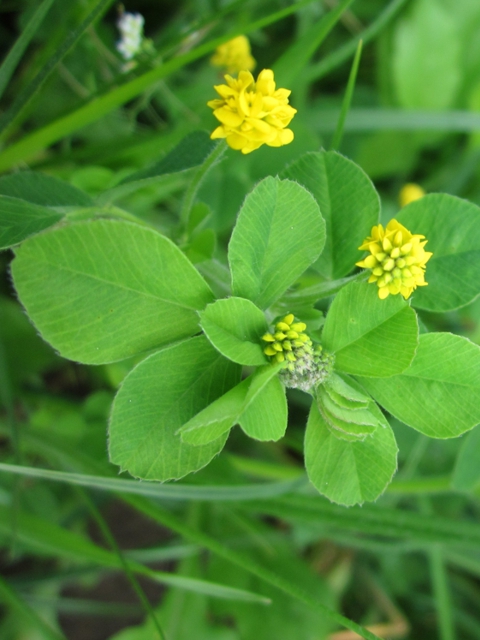 |  |  |  |  |
 |  |  |
Black Medick is an annual, rarely biennial plant. Many stems, 10-35 cm tall, branching at the base, thin, fragile, usually upright or raised. The leaves are trifoliate, consisting of three leaflets. Leaves 7-15mm long, 3-9mm wide, inverted ovate or almost diamond-shaped, wedge-shaped at the base, toothed with a groove at the apex. Petals 1/3 or up to 1/2 fused, ovate-lanceolate, broad-lanceolate or lanceolate, pointed, upper with a smooth edge, lower with 1-3 triangular teeth. Petioles short (<1cm), rarely longer on lower leaves (<7cm). Stems and leaves glabrous, hairy or covered with rough hairs.
The flower is small, 1-4 mm in size, light yellow. Placed in a head-type inflorescence. Inflorescence 5-15mm long and 7-8mm in diameter, dense, ovoid or elongated ovoid. The inflorescence consists of 10-30 flowers.
Fruit a 2-3mm long pod, about 1mm in diameter, kidney-shaped, without spines, naked or covered with rough hairs. When ripe, they turn black, with distinct veining on the back, one seed inside. Seeds ovoid or oval, smooth, yellow, yellow-green or brownish 1.5-2mm long and 1-1.5mm in diameter.
The plant blooms from the end of May to the beginning of September.
For medicinal purposes, the above-ground part of Black Medick is collected during its flowering. Dry in a well-ventilated and shaded place. Drying in forced dryers not exceeding 40C is allowed. The drug is stored in a breathable container for up to 2 years.
Protein, fiber, alkali, fluorine, calcium, magnesium and iron are found in the plant. Also, Black Medick contains saponins, tannins, essential oil and phytoestrogen-like substances. Carotene, vitamin C and D are found in the leaves.
Medicinal significance
Black Medick is an ancient remedy, which has been known in folk medicine for a long time, while in official medicine, the ability of alfalfa to remove toxic elements from the body and reduce cholesterol levels was determined very recently.
Folk scientists recommend making ointments, poultices and compresses from Black Medick . Such preparations treat joints, nervous disorders, dermatological pathologies, diseases of the digestive tract, diabetes, colds, hemorrhoids, as well as cope with gynecological problems (colpitis), ophthalmological problems and even prostatitis. And these are not all the problems that this little plant can handle.
It is important to know that this plant is especially important for women who have reduced lactation. On the other hand, a daily tea in which a Black Medick is added will be able to ease the condition of women who have started menopause.
Official medicine is also actively working on the use of this plant in various preparations. On the other hand, experts recommend using this plant as a nutritional supplement.
The plant is also edible, it is used in soups and salads; grind the seeds into flour and add to the bread.
